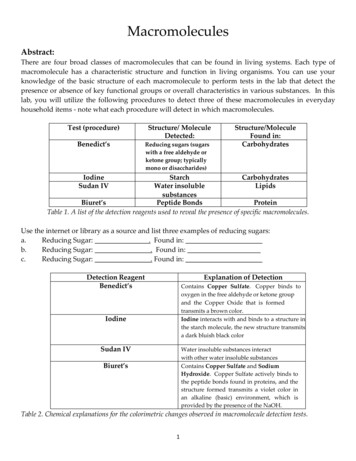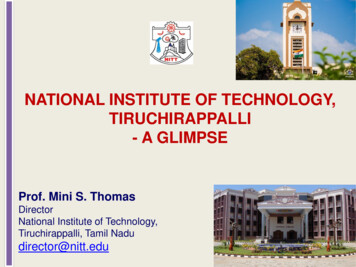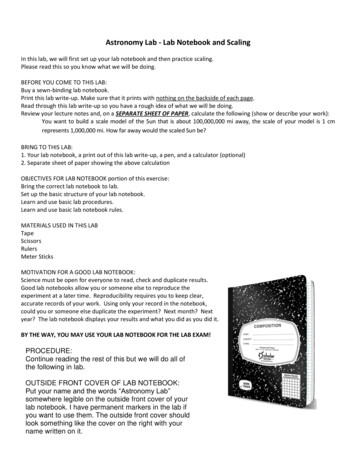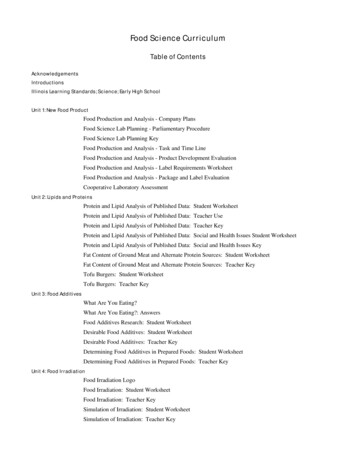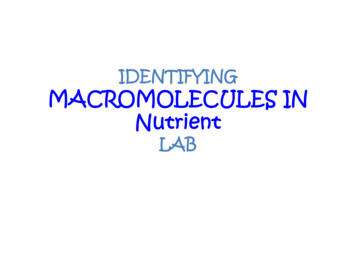
Transcription
IDENTIFYINGMACROMOLECULES INNutrientLAB
In this lab, with the use ofindicators as chemicaldetection tools, you willanalyze a variety of foodsfor the presence ofnutrients.Detection is based uponobserving a chemicalchange that takes placemost often a change incolor.
Lab ObjectiveIdentify the presence of major nutrients such assimple carbohydrates (glucose), complexcarbohydrates (starch), protein and fat incommon foods.
What is an indicator? Indicators are chemical compounds used todetect the presence of other compounds.
Background InformationINDICATORMACROMOLECULENEGATIVE k redblackBiuretsolutionproteinblueviolet,blackSudan IVlipiddark redreddishorange
Test for Simple CarbohydratesBenedict’s solution Benedict's solution is a chemical indicator for simplesugars such as glucose: C6H12O6. Aqua blue: negative test;yellow/green/brickred, etc.: positive test
Test for Simple CarbohydratesBenedict’s solution Unlike some other indicators, Benedict’ssolution does not work at room temperature ‐it must be heated first.
Test for Complex CarbohydratesIodine Solution Iodine solution Æ color change blue to black
Test for Complex CarbohydratesIodine solution Iodine solution is an indicator for a molecule calledstarch. Starch is a huge molecule made up of hundreds ofsimple sugar molecules (such as glucose) connectedto each other.
Test for Protein (amino acids)Biuret solution Biuret solution Æ dark violet blue to pinkishpurple
Test for Fats (lipids)Sudan IV If lipids are present the Sudan IV will stain themreddish‐orange (positive test).
QuestionWhy didn’t the test tube containing sucrosechange colors?
QuestionWhy didn’t the test tube containing starchchange colors?
Reducing and Non‐Reducing Sugars Reduction is the chemist’s term for electron gain A molecule that gains an electron is thus – “reduced” A molecule that donates electrons is called a – “reducing agent” A sugar that donates electrons is called a – “reducing sugar” The electron is donated by the carbonyl group Benedict’s reagent changes colour when exposed toa reducing agent
Benedict’s Test Benedict’s reagent undergoes acomplex colour change when itis reduced The intensity of the colourchange is proportional to theconcentration of reducing sugarpresent The colour change sequence is:–––––Blue green yellow orange brick red
The carbonyl group ‐ monosaccharides The carbonyl group is “free”in the straight chain form But not free in the ring form BUT remember – the ringform and the straight chainform are interchangeable So all monosaccharides arereducing sugars All monosaccharides reduceBenedict’s reagent
The carbonyl group –disaccharides ‐ maltose In some disaccharidese.g. maltose one of thecarbonyl groups is still“free” Such disaccharides arereducing sugars They reduce Benedict’sreagent
The carbonyl group –disaccharides ‐ sucrose In some disaccharides e.g.sucrose both of thecarbonyl groups areinvolved in the glycosidicbond So there are no freecarbonyl groups Such sugars are called non‐reducing sugars They do NOT reduceBenedict’s reagent
The carbonyl group –disaccharides ‐ sucrose The subunits of sucrose(glucose and fructose) arereducing sugars If sucrose is hydrolysed thesubunit can then act asreducing sugars This is done in the lab byacid hydrolysis After acid hydrolysis sucrosewill reduce Benedict’sreagent
Gatton College of Business and Economics Created Date: 1/13/2011 9:03:53 AM .
